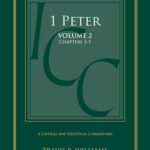Exodus and Biblical Theology
“[A]n understanding of the Exodus is…essential for understanding and probing the theology of the Bible as it unfolds historically.”
Stephen Dempster makes this point in a recent article on the role of Exodus in biblical theology titled “Exodus and Biblical Theology: On Moving into the Neighborhood with a New Name.” Here I’d like to pass on two categories of observations Dempster makes in the piece that I found particularly helpful in thinking through Exodus’s role in the Bible’s storyline. I’m sort of cherry-picking, so, if you’re hungry for a bit more, you’ll just have to read the entire piece.
(1) The importance of the Exodus in the OT. The piece begins with a handful of notes about the pervasive influence of the Exodus in the OT. For starters, it’s referenced explicitly some 120 times—the sort of data one looks for, esp. when trying to discern the intention in narrative lit. (How else do we expect a narrator to make his point—John 20:31 is a bit unusual for the genre.) Beyond this, Dempster adds, the event fundamentally shaped Israel’s hymnody (see, e.g., Ps 66:6; 74:13–14; 77:16–20), eschatological vision (see, e.g., Hos 1:11 [2:2 MT (וְעָלוּ)]; Mic 4:6–7) and calendar (i.e., Israel’s new year celebrated the anniversary of Yhwh’s presence in the community; see Exod 40:17)—to say nothing of its ethics, which Dempster intriguingly describes as rooted in the indicative of the Exodus (i.e., I am Yhwh your God who brought you out of Egypt therefore have no other gods before me…). (The Red Sea preceded Sinai, as Keller puts it in another place.)
(2) The role of Exodus in the OT. In his third (“The First-Paragraph—The Story of Exodus in the Context of the Story of Scripture”) and fourth major pts. (“Exodus—The Larger Structure: Deliverance, Covenant, Presence”), Dempster probes the role of Exodus in the OT. He begins with a reflection on the conjunction (“and”) that begins the book, observing that it leads the reader to expect that he’ll find in what follows a continuation of the narrative begun in Genesis. This expectation, he goes on to show, is confirmed in the book’s first paragraph, with its talk, e.g., of Jacob’s numerous family (see Exod 1:5, 7), a description that immediately recalls both humanity’s original mandate (Gen 1:28) and God’s promise to Abraham (Gen 12:2; 13:16; 15:5). It is, in fact, this latter connection that suggests the story that follows will continue to reveal how God intends to use Abraham and his family to regain what humanity lost in the Fall (see, esp., Gen 12:2–3). The connection with the Abraham narrative also helps explain Pharaoh’s (stubborn) fury, which plays such a large role in the subsequent narrative. After all, God’s original promise to Adam and its reiteration to Abraham came with an expectation of struggle: there would be opposition from the Serpent’s seed (Gen 3:15), which is to say, there would be those who would curse God’s people (see, e.g., Gen 12:2; also “enemies” in 22:17). It’s also the connection with the Abraham story that helps us understand the role God gives to his covenant people at Sinai. They were to be a kingdom of priests (Exod 19:5–6). Israel, in other words, like Abraham, was created for the world. As Dempster notes, “Israel is called to be a community of priests whose congregation is nothing less than the globe. The end of the covenant is not Israel’s own salvation but the inclusion of the nations” (14). Her calling, as he says in another place, “is fundamentally missiological. [Israel’s] purpose for existence [is] the restoration of the world to its pre-Edenic state” (13).
Note: For a similar reading, see Wellum and Gentry, Kingdom through Covenant, 301–56 (esp. the convenient summary on 302–4).



What about how the OT Exodus and prophets topologically anticipate the ultimate Exodus found in Jesus Christ? True Biblical theology shows this typological anticipation of Christ.
Good question. Dempster talks about this briefly in his piece, see 19-20 and, also, 5-6.
Thanks! I’m interested to see how these “typological continuities” (if I can call them that) work out in a dispensational framework. At the moment, I have a hard time seeing how dispensationalism does biblical theology well. By appearances, it seems to be better at dividing scripture into discontinuities than showing the overarching metanarrative through continuities.
Thanks.
Nice comment, Seminary Student (I’m an ’06 DBTS grad)! Maybe therein lies the opportunity for dispys to develop the system over the next decades, but… I don’t know about that.
And, I wonder if dispys might resent our phrase “dividing scripture into discontinuities”. Just thinking out quiet…
wep
Seminary student: see if this helps: https://dbts.edu/blog/kingdom-through-covenant-a-dispensational-review/. I think the author gets it just about right, though I still have a few questions.
I’ve read KTC; and, although I’m not a student of yours (i.e., not at DBTS), I actually managed to get a hold of your review. It was helpful. Thanks.
Hello, I thought I might throw a comment on here regard the NT interpretation of these same events, how the people of God now is the fulfillment of the people of old who passed through the waters, all being baptized yet not all being destined to believe and enter the land. The NT picture of the covenanted people being wider than true believers, and of the baptized community being all equally called to faith, testifies that the NT people of God functions similarly to the OT, with a marked out body being on a pilgrimage as an earthly people, having come out of the world through a flood symbolizing the wrath of God (baptism), and having passed through those waters of death and having passed through to go be brought on a pilgrimage, as we now are marching to zion, are fed with the manna of the Lord’s Supper to sustain and strengthen, and only those who enter by faith will see the Promised Land of the world to come. As a presbyterian, this has become one of the strongest evidences that those who are baptized and participate in tasting the powers of the age to come are broader than simply believers. Just as the children were not left behind in the exodus, so also the pilgrimage we are on includes the Gen 17promise that is reiterated from Abraham on Pentecost, that the promise is directed to us, to our children, and now those God will call from the nations (the latter requiring of course a change in the sign to one which symbolizes the exodus initiation instead republishing the physical nation initiation where blood must be shed and physical propagation is commended. 1 Cor 10, Heb 3:7-4:13, Rom 9-11 are all helpful to demonstrate that the body with which God has to do now on earth is not simply an aggregated atomistic collection of believers, but a single body baptized into Christ, which He sovereignly calls and of which not all Israel will be found to be Israel on the last day, but only those who combine the promise with faith. Again, consider the sequence, as in the old, so in the new, 1.)the passover lamb is sacrificed and the blood is over the house, 2.) all the households and nation passes through the waters which remove us from slavery and place us with a people and on a trek toward the promised land. 3.) The first stop is the mountain which our new Moses has ascended and has sent down the law into our hearts, fulfilling Jeremiah 31, and 4.) we now on this journey are tasting the powers of the age to come as covenant members coming to the table of the Lord. Just as all israel was baptized and all Israel ate at the table (1 Cor 10), not all Israel entered the land then or now which is only accessible by grace alone through faith alone in Christ alone. Christ our passover has been sacrificed, and the lamb has become the lawgiver, as our leader the new moses is also the new Joshua, who goes up the mountain to see God face to face, and as our Mediator sends down God’s law/instrustions/testimony into our hearts now of flesh, as the helper reminds us of all His will (law) and testifies to that rock which follows us which is Christ, that rock that streams of water now come forth from in our hearts just as water did from that rock that followed them in the desert, and led them in the desert, the rock being Christ. If being baptized into Christ is not covenant membership, then there is difficulty with the covenant breaking passages and warnings of hebrews. If however there is a place for God actually tethering real covenant membership to the visible historical body on earth through the sacrament, then we have a biblical distinction which involves three spheres biblically defined and delineated: the world, the covenant, and the elect, baptism being associated with the earthly covenant, not with election. That my friends is the NT understanding and what causes baptists to become presbyterians as they study their bibles, since the NT writers take us in this direction that just cannot allow the reverse. The story of Judson moving from paedobaptism to believers is radically against the overwhelming trend of movement, in fact I have never met or heard of a biblically mature presbyterian who converted though the reverse has been the regular testimony, just as the trend is for dispensational-raised or trained people to mature into covenant theologians through reading their bibles. Hope this helps someone. Feel free to offer some biblical rebut. Might be helpful to work through what is being said in 1 Cor 10. Understanding that passage alone will topple the most entrenched baptist. Pro Rege, Phil Hodson